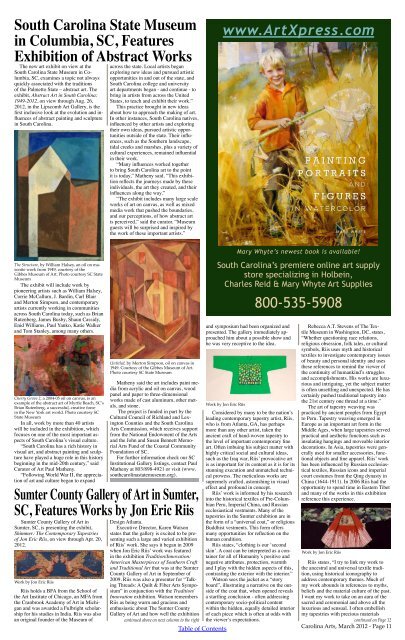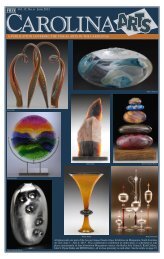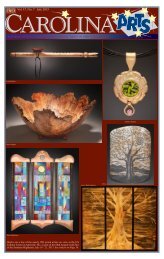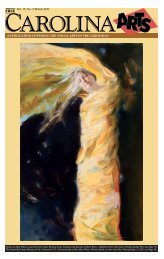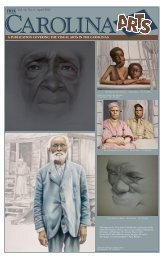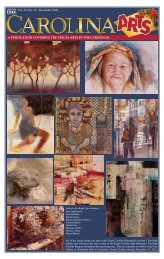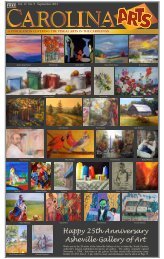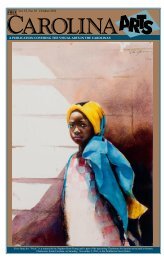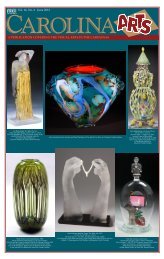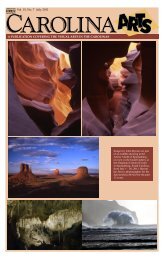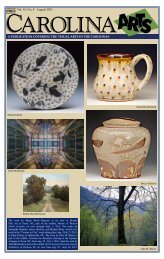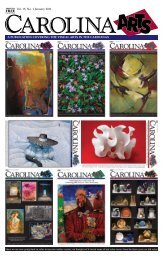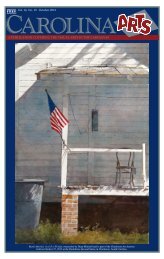Vol. 16, No. 3 March 2012 - Carolina Arts
Vol. 16, No. 3 March 2012 - Carolina Arts
Vol. 16, No. 3 March 2012 - Carolina Arts
Create successful ePaper yourself
Turn your PDF publications into a flip-book with our unique Google optimized e-Paper software.
South <strong>Carolina</strong> State Museumin Columbia, SC, FeaturesExhibition of Abstract WorksThe new art exhibit on view at theSouth <strong>Carolina</strong> State Museum in Columbia,SC, examines a topic not alwaysquickly associated with the traditionsof the Palmetto State – abstract art. Theexhibit, Abstract Art in South <strong>Carolina</strong>:1949-<strong>2012</strong>, on view through Aug. 26,<strong>2012</strong>, in the Lipscomb Art Gallery, is thefirst inclusive look at the evolution and influencesof abstract painting and sculpturein South <strong>Carolina</strong>.across the state. Local artists beganexploring new ideas and pursued artisticopportunities in and out of the state, andSouth <strong>Carolina</strong> college and universityart departments began - and continue - tobring in artists from across the UnitedStates, to teach and exhibit their work.”This practice brought in new ideasabout how to approach the making of art.In other instances, South <strong>Carolina</strong> natives,influenced by other artists and exploringtheir own ideas, pursued artistic opportunitiesoutside of the state. Their influences,such as the Southern landscape,tidal creeks and marshes, plus a variety ofcultural experiences, remained influentialin their work.“Many influences worked togetherto bring South <strong>Carolina</strong> art to the pointit is today,” Matheny said. “This exhibitionreflects the journeys made by theseindividuals, the art they created, and theirinfluences along the way.”“The exhibit includes many large scaleworks of art on canvas, as well as mixedmedia work that pushed the boundaries,and our perceptions, of how abstract artis perceived,” said the curator. “Museumguests will be surprised and inspired bythe work of these important artists.”www.ArtXpress.comThe Structure, by William Halsey, an oil on masonitework from 1949, courtesy of theGibbes Museum of Art. Photo courtesy SC StateMuseumThe exhibit will include work bypioneering artists such as William Halsey,Corrie McCallum, J. Bardin, Carl Blairand Merton Simpson, and contemporaryartists currently working in communitiesacross South <strong>Carolina</strong> today, such as BrianRutenberg, James Busby, Shaun Cassidy,Enid Williams, Paul Yanko, Katie Walkerand Tom Stanley, among many others.Cherry Grove 2, a 2004-05 oil on canvas, is anexample of the abstract art of Myrtle Beach, SC’sBrian Rutenberg, a successful, creative forcein the New York art world. Photo courtesy SCState MuseumIn all, work by more than 40 artistswill be included in the exhibition, whichfocuses on one of the most important aspectsof South <strong>Carolina</strong>’s visual culture.“South <strong>Carolina</strong> has a rich history invisual art, and abstract painting and sculpturehave played a huge role in this historybeginning in the mid-20th century,” saidCurator of Art Paul Matheny.“Following World War II, the appreciationof art and culture began to expandSumter County Gallery of Art inSumter, SC, is presenting the exhibit,Shimmer: The Contemporary Tapestriesof Jon Eric Riis, on view through Apr. 20,<strong>2012</strong>.Untitled, by Merton Simpson, oil on canvas in1949. Courtesy of the Gibbes Museum of Art.Photo courtesy SC State MuseumMatheny said the art includes paint mediafrom acrylic and oil on canvas, woodpanel and paper to three-dimensionalworks made of cast aluminum, other metals,and stone.The project is funded in part by theCultural Council of Richland and LexingtonCounties and the South <strong>Carolina</strong><strong>Arts</strong> Commission, which receives supportfrom the National Endowment of the <strong>Arts</strong>and the John and Susan Bennett Memorial<strong>Arts</strong> Fund of the Coastal CommunityFoundation of SC.For further information check our SCInstitutional Gallery listings, contact PaulMatheny at 803/898-4921 or visit (www.southcarolinastatemuseum.org).Sumter County Gallery of Art in Sumter,SC, Features Works by Jon Eric RiisWork by Jon Eric RiisRiis holds a BFA from the School ofthe Art Institute of Chicago, an MFA fromthe Cranbrook Academy of Art in Michiganand was awarded a Fulbright scholarshipfor his studies in India. Riis was alsoan original founder of the Museum ofDesign Atlanta.Executive Director, Karen Watsonstates that the gallery is excited to be presentingsuch a large and varied exhibitionof Riis’ work. She says it began in 2009when Jon Eric Riis’ work was featuredin the exhibition Tradition/Innovation:American Masterpieces of Southern Craftand Traditional Art that was at the SumterCounty Gallery of Art in September of2009. Riis was also a presenter for “TalkingThreads: A Quilt & Fiber <strong>Arts</strong> Symposium”in conjunction with the Tradition/Innovation exhibition. Watson remembersRiis as being warm and gracious andenthusiastic about The Sumter CountyGallery of Art and how well the exhibitioncontinued above on next column to the rightTable of ContentsMary Whyte’s newest book is available!South <strong>Carolina</strong>’s premiere online art supplystore specializing in Holbein,Charles Reid & Mary Whyte Art Suppliesand symposium had been organized andpresented. The gallery immediately approachedhim about a possible show andhe was very receptive to the idea.Work by Jon Eric RiisConsidered by many to be the nation’sleading contemporary tapestry artist, Riis,who is from Atlanta, GA, has perhapsmore than any other artist, taken theancient craft of hand-woven tapestry tothe level of important contemporary fineart. Often imbuing his subject matter withhighly critical social and cultural ideas,such as the Iraq war, Riis’ provocative artis as important for its content as it is for itsstunning execution and unmatched technicalprowess. The meticulous works aresupremely crafted, astonishing in visualeffect and profound in concept.Riis’ work is informed by his researchinto the historical textiles of Pre-ColumbianPeru, Imperial China, and Russianecclesiastical vestments. Many of thetapestries in the Sumter exhibition are inthe form of a “universal coat,” or religiousBuddhist vestments. This form offersmany opportunities for reflection on thehuman condition.Riis states, “clothing is our ‘secondskin’. A coat can be interpreted as a containerfor all of Humanity’s positive andnegative attributes, protection, warmthand I play with the hidden aspects of this,contrasting the exterior with the interior.”Watson sees the jacket as a “storyboard”, illustrating a narrative on the outsideof the coat that, when opened revealsa startling conclusion - often addressingcontemporary socio-political contentwithin the hidden, equally detailed interiorof each piece which is often at odds withthe viewer’s expectations.800-535-5908Rebecca A.T. Stevens of The TextileMuseum in Washington, DC, states,“Whether questioning race relations,religious obsession, folk tales, or culturalsymbols, Riis uses myth and historicaltextiles to investigate contemporary issuesof beauty and personal identity and usesthese references to remind the viewer ofthe continuity of humankind’s strugglesand accomplishments. His works are luxuriousand intriguing, yet the subject matteris often unsettling and unexpected. He hascertainly pushed traditional tapestry intothe 21st century one thread at a time.”The art of tapestry weaving waspracticed by ancient peoples from Egyptto Peru. Tapestry weaving emerged inEurope as an important art form in theMiddle Ages, when large tapestries servedpractical and aesthetic functions such asinsulating hangings and moveable interiordecorations. In Asia, tapestries were generallyused for smaller accessories, functionalobjects and fine apparel. Riis’ workhas been influenced by Russian ecclesiasticaltextiles, Russian icons and imperialcourt costumes from the Qing dynasty inChina (<strong>16</strong>44-1911). In 2006 Riis had theopportunity to spend time in Eastern Tibetand many of the works in this exhibitionreference this experience.Work by Jon Eric RiisRiis states, “I try to link my work tothe ancestral and universal textile tradition,using historical iconography toaddress contemporary themes. Much ofmy work abounds in references to myths,beliefs and the material culture of the past.I want my work to take on an aura of thesacred and ceremonial and above all theluxurious and sensual. I often embellishmy tapestries with precious materialscontinued on Page 12<strong>Carolina</strong> <strong>Arts</strong>, <strong>March</strong> <strong>2012</strong> - Page 11


